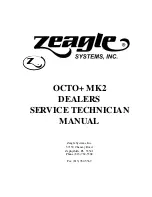
With the end cover and diaphragm assembly
removed, connect the regulator to an air supply
of 125-135 psi. The objective is to minimize
the free movement in the lever by adjusting the
nyloc nut as shown in Fig. 1.
It is important to understand that the free
movement in the lever will be greater at higher
pressure and less at lower pressure. The rec-
ommended adjusting pressure of 125-135 psi
has been chosen to give the regulator satisfac-
tory performance across the range of approxi-
mately 110-160 psi. Ideally the best possible
performance would be achieved by adjusting
the free movement while connected to the cus-
tomer's own first stage, or an equivalent pres-
SECTION 3 - TESTING AND ADJUSTING THE REGULATOR
Use the blade of the special OCTO+ wrench,
APS010, inserted through the mouthpiece to
prevent the valve turning, as shown in Fig. 1.
Turn clockwise to relieve spring pressure, low-
ering the lever or counter clockwise to increase
spring pressure, raising the lever. Turn the
nyloc nut until you create a free flow, then turn
nyloc nut back to stop the free flow.
Adjust the
Nyloc
Nut
using a 7/32”
or 5.5 MIM socket
0.25 - 0.75 MIM
Free Movement
at 125 - 135 PSI
8.5 - 9.5 BAR
Special
wrench to
prevent the
valve turning
Adjust the
Nyloc Nut
APS010
Fig. 1































